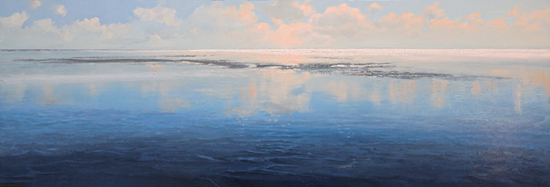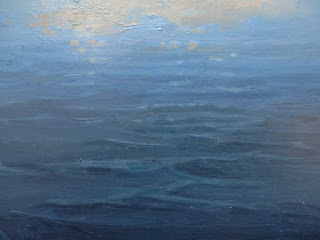This week I started working on a one person exhibition early next year in De twee Pauwen Art Gallery. De Twee Pauwen means 'the two peacocks' and the gallery honors it's name. Exactly 10 years ago they hosted a solo show of my work for the first time. It was quite successful and after that I was invited back every two years.
Most of the exhibitions I'm participating in are group shows. Since the economic crises galleries are reluctant to take the risk of a one person exhibition, so I'm really glad with the Two Peacocks. It illustrates the importance of a gallery that believes in your work. Nothing worse than driving home after an exhibition with the same paintings you dropped off a few weeks earlier...
 |
| Foggy Sunrise, oil on panel, 15 x 50 cm |
So to prevent that I'll give you my 5 tips for a successful exhibition (apart of course from doing brilliant paintings):
1. Make sure you're in the right gallery.
Duhuh, I hear you think. But it's is not as self evident as it seems. If you don't get a lot of opportunities to show your work, you maybe tempted to be content with the mere fact that a gallery invites you at all. Still it makes sense to do some research to find out if your work fits in. Look at their artists and maybe write one of them an email to find out what the gallery is about.
2. A prompt answer says a lot.
When I receive an email from a gallery I try to respond the same day, or the next day at the latest. I like my galleries to do the same. When it takes them a week (or sometimes more!) to answer they should at least apologize for their late response. Otherwise: forget it. It takes a lot of effort, time and money on your part to participate. The way a gallery communicates with it's artists says a lot about the effort they're going to put in. Some of the worst experiences I had could have been avoided if I just paid attention to their reaction time.
3. Do the paperwork.
When you're working with a gallery for the first time it's a good idea to have the gallery conditions on paper. At least have them confirm by email the most important points: their percentage, the exhibition period, the number and sizes of the works, insurance, that kind of stuff.
4. Do the numbers.
When you've done your homework you know which price range the gallery is in. For a successful exhibition it's important to stay within that range. If you have to change your prices to fit in, remember: once you raised them it's a problem to lower them when times get hard. Galleries hate it when that happens. It sends a message to their buyers their artists are overpriced.
5. Enjoy the ride.
With all these do's and don't's you'd almost forget the reason for all this: painting. For an exhibition like this I like to focus on a certain aspect of my work. Last time I did a lot of reflections, this time it's going to be clouds, my core business. I enjoy visualizing the gallery filled with my works, each one of them absolutely brilliant of course. Can't wait to turn my ideas into actual paintings. I'll keep you posted.



















































